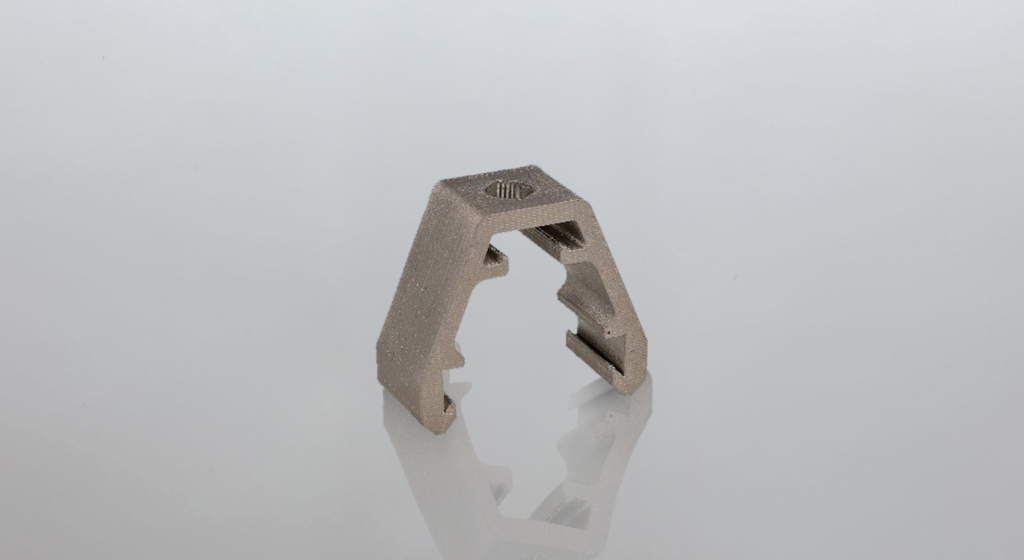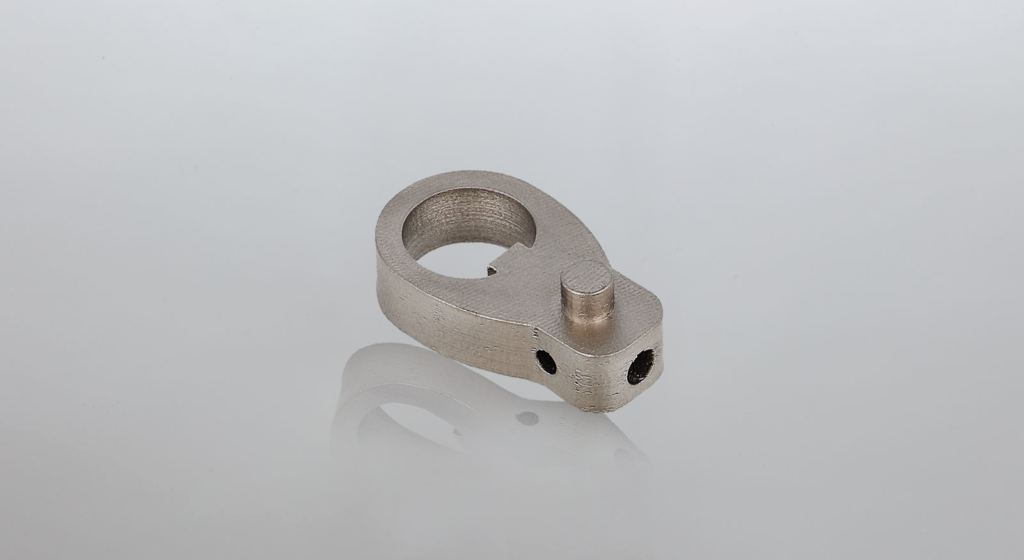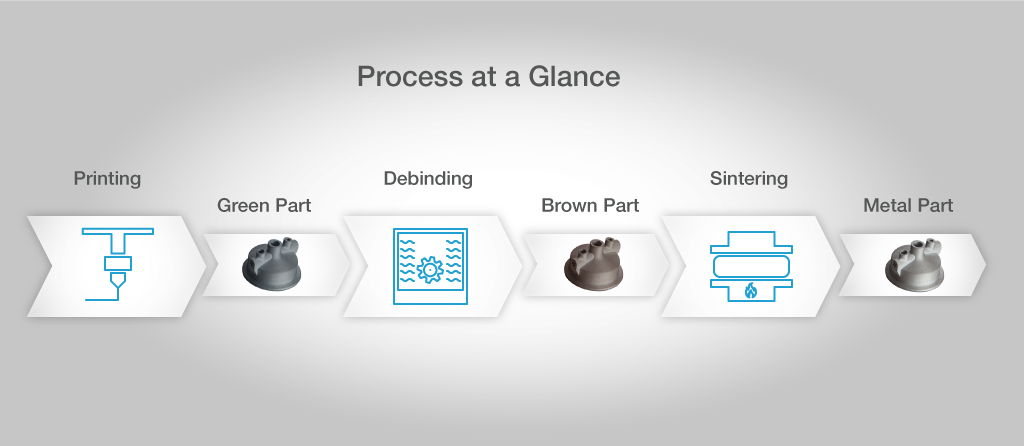BASF‘s Forward AM unit has launched 17-4 PH metal filament for FDM printers. 17-4 PH is a commonly used stainless steel that can cover a lot of applications in machine building and in industry. With their metal filament, you can print on common FDM printers, such as BCN3D or Prusa machines, and then debind and sinter the part to get a metal component.
The filament has two binders in it. First, you print what is called the “green part”, which is then catalytically debound, becoming a “brown part”. Next, the second binder is removed via sintering in a furnace. After you post-process through polishing or another process.

The process overall is rather finicky, but this could be an important way to make inexpensive metal parts in the future; in competition with binder jetting and lost wax casting. The company mentions tooling, jigs, fixtures. end-use parts, and prototypes as possible applications. Firat Hizal, Head of Metal Systems Group, BASF 3D Printing Solutions, said of the new product:
“Ultrafuse 17-4 PH is an outstanding result of our strong R&D commitment. We filamented more than 10 different metals from titanium to tool-grade steels, and several alternative materials to print support structures within this year. Going forward we will continue to introduce the new filaments that the market and our customers demand.”
Along with 17-4 PH, the company also offers 316L steel. It’s exciting to see that they’re working on titanium and tool steels, as well. BASF has been pushing for this technology to become a reality publicly since 2018 and if they show commitment it may yet happen.

A solar panel clamp.
I’ve always been excited but reserved about the prospects of FDM metal filament. The long-term prospects of metal filament to making inexpensive metal parts are good. But, parts have to be printed, debound and sintered. Shrinkage occurs in these processes and this is often difficult to account for. Also, debinding can be tricky to perform in-house in many environments.
Additionally, cost-effective equipment for debinding and sintering aren’t widely available. Nabertherm ovens are great, but pricy for some. French firm Zetamix which specializes in ceramics using a similar method has the equipment as well. I still think that metal filament is a process that is too tricky to take on for most companies at the moment (it uses formaldehyde for example). Suppliers need to make more integrated equipment and solutions available and more work has to be done on settings and shrinkage. For a look at how a novice has trouble with such a technology, read Michael Molitch-Hou’s review of Copper Filament from The Virtual Foundry.
For the near term, I’m skeptical about the immediate prospects of this technology. However, in the long-term for making series of spare and other parts, this could be a huge technology and a huge application for FDM systems. FDM systems are numerous and a chaotic innovation system has emerged where competition is driving prices down on the low end, while more capable pro machines flourish at the enterprise level. This competitive system is formidable and growing quickly in installed base as well as capabilities.
Once vendors in this space see the path to series part production for some components, they will jump on it. Print strong with metal rather than print strong like metal. Metal filament, plus the complete settings, better shrinkage estimations, and a sintering oven and a debinding station, can let most 3D printers print metal parts. We still need to find the right applications and post-finishing, but this could be huge.

A spare gate lock part.
For this to happen, someone has to jump on the totally obvious task of making inexpensive debinders and sintering ovens. This, so far, has not happened. At the moment Markforged is the only firm that offers a complete solution that could work for this FDM filament, as well. I’d urge them to sell their ovens and debdinders to the rest of the market.
In addition, however, other companies would have to join the fray. It would make a great product expansion for an oven firm, a 3D printing OEM or a new startup. Few at the moment are making the equipment that a small engineering firm could use to do this in their garage. There simply isn’t a tried and true. a product line that you can buy that will let your small metal shop print metal parts. Although second-hand lab equipment sites are often a good source. It’s worth noting that The Virtual Foundry, who Molitch-Hou also interviewed for his 3D Printing for Preppers series, has begun selling kilns for their broad portfolio of metal 3D printing filaments.

I think that making and selling this process chain is a significant opportunity for a business. It would also be a requirement in my mind for metal 3D printing filaments to get really big that a few vendors venture into this space to make this possible. The shrinkage is problematic, but the rest of the equation is tried and true with well-known requirements.
At the same time we’d also need a good application fit for these parts at their price points. For example, something such as a spare part that has been tested and prints all over the world in three locations as a “b-side” metal part in a series of one to 10,000 and is less than 5cm in size and does not need super-flat surfaces. Something in this area would be a great example.

A tool insert.
In the below video you can see a use case for the 17-4 material, with spare parts company Sparox. It’s in Austrian, but the video shows the parts quite well (I didn’t think Austrian was a language either until I heard this). I really like their application as well, out of production spare parts, such as clips for solar panels and tool inserts as well.
BASF
Through collaboration with Sparox and the like, BASF is building out the ecosystem for this material as well as showcasing some real live fire examples of these parts in the wild. At the same time, the company is being rather innovative in solving the problem of the non-availability of inexpensive safe debinders and sintering ovens. The company is letting you upload and order parts using their metal filament from their 3D printing service Sculpteo.
This is a great decision that will be an inexpensive way for a company or person to see if this technology will work for their application. If you’re a business that uses metal parts or uses metal spares I urge you to try to do this. It will be difficult but if it works for you, these parts are hilariously cheap to make. To be sure, I still don’t like this for unique parts, but do think it will work for some series.
At the same time, you can also buy the filament, print the part, and send it to a distributor, where the part will be debound and printed. That way, before you spend a ton of time researching if this could work, you can just invest in one role and some time and find out if a part would work on your printer. BASF also offers simulation services, which can help you tackle the challenge of getting your geometry right. All three services will greatly reduce the time to market and really help customers evaluate this as technology quickly and inexpensively. Really great to see BASF roll out this offering.
The below three videos are actually a great introduction to this path to metal printing. A lot of the issues are discussed and explained very clearly.
Subscribe to Our Email Newsletter
Stay up-to-date on all the latest news from the 3D printing industry and receive information and offers from third party vendors.
Print Services
Upload your 3D Models and get them printed quickly and efficiently.
You May Also Like
3D Printing News Briefs, July 2, 2025: Copper Alloys, Defense Manufacturing, & More
We’re starting off with metals in today’s 3D Printing News Briefs, as Farsoon has unveiled a large-scale AM solution for copper alloys, and Meltio used its wire-laser metal solution to...
3DPOD 260: John Hart on VulcanForms, MIT, Desktop Metal and More
John Hart is a Professor at MIT; he´s also the director of the Laboratory for Manufacturing and Productivity as well as the director of the Center for Advanced Production Technologies....
3D Printing News Briefs, June 28, 2025: Defense Accelerator, Surgical Models, & More
In this weekend’s 3D Printing News Briefs, 3YOURMIND was selected to join an EU Defense Accelerator, and PTC has announced model-based definition (MBD) capabilities within Onshape. Finally, a study out...
EOS in India: AM’s Rising Star
EOS is doubling down on India. With a growing base of aerospace startups, new government policies, and a massive engineering workforce, India is quickly becoming one of the most important...

































